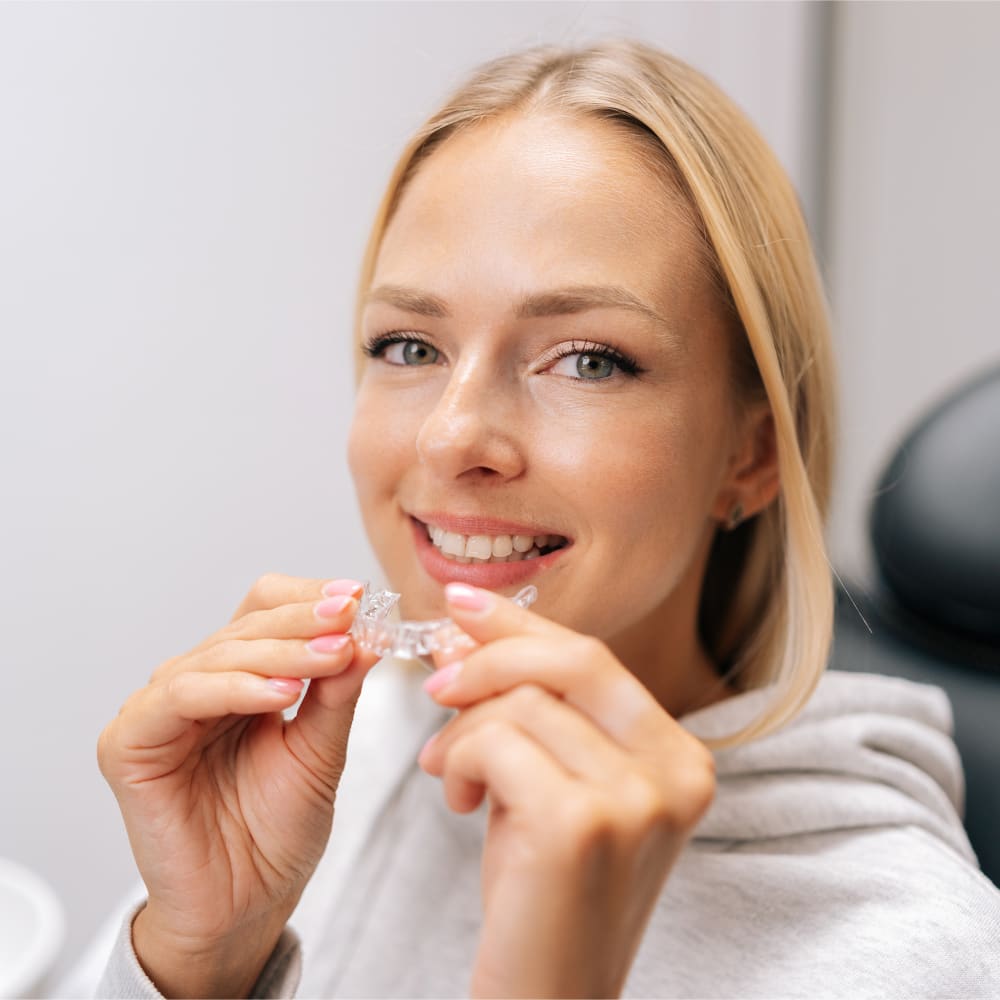Maintaining Your New Smile
Once you have completed your active orthodontic treatment, a retainer becomes vital to keeping your teeth in their new, corrected position.
When your braces come off or you've removed your final set of aligners, it's time for the maintenance phase of your treatment. During this time, your teeth are susceptible to shifting back into their old positions. A retainer can prevent this from happening.
At Woodstock Orthodontics, we offer clear retainers, which are removable trays that fit snugly over your upper or lower teeth. Made from smooth, durable plastic, they are designed to maintain your tooth alignment after orthodontic treatment. Because they’re virtually invisible and custom-made for your smile, Essix retainers offer a discreet and comfortable way to preserve your results.
We also offer fixed retainers. which are wires that are bonded to the backs of your lower front teeth. These teeth are particularly prone to shifting throughout adulthood, and that's why fixed retainers are often recommended.
Retainers are the essential final step in your orthodontic treatment journey. You've worked so hard to get your smile here; now focus on maintaining it.

Flexible In-Housing Financing
At Woodstock Orthodontics, we believe that finances should never be a barrier to a healthy smile. Our team would be happy to work with you to develop a zero-interest payment plan to fit your budget. Now that's worth smiling about!
Why You Need a Retainer
Retainers are dental appliances used after orthodontic treatment to stabilize your teeth in their new positions and prevent them from shifting.
During the active part of your orthodontic treatment, your aligners or braces are continuously working to move your teeth and their roots into new positions. As the roots move, the bone surrounding them needs to reform to be able to hold them securely again.
This process can go on for many months after after the tooth has first moved.
Preserving Your Results
Wearing a retainer helps to stabilize your teeth while the jaw heals, giving it the time it needs to reform and harden around the roots. This can stop the teeth from shifting back to their original positions, undoing all of your orthodontic treatment.
Retainer FAQs
Read on to find out more about retainers through our most frequently asked questions.
-
How long do I have to wear my retainer?
Retainers are a long-term commitment for orthodontic patients who want to maintain their smiles. They ensure that your new, straighter smile stays that way after your treatment with braces or clear aligners is complete.
Your orthodontist will provide guidance on how frequently you should wear your retainers, based on your specific needs. To maintain your alignment long-term, it’s important to continue wearing your retainer throughout your entire life.
-
How often do I have to wear my retainer?
Your orthodontist will let you know how often you need to wear your retainers to keep your teeth from shifting into their pre-treatment positions. The duration of time may differ from patient to patient depending on the severity of your original orthodontic condition.
At that time, you'll only take your retainer out to eat, brush, and floss your teeth, or if you need to put in a sports mouth guard.
Over time, your teeth will settle into their new positions, and your risk of relapse will decrease. When your orthodontist has determined you are ready, you will be able to start wearing your retainer for fewer hours a day. For many people, this means overnight retainer wear only.
-
How often should I replace my retainer?
With proper care and correct use, most retainers can last for years.
The following signs indicate that a new retainer might be in order:
Cracks or Chips
If your retainer is chipped or cracked, it is time to replace it. This type of damage will only get worse over time, and it will also compromise the retainer's structural integrity, making it less effective.
Poor Fit
Retainers are designed to be sturdy and durable, but they can start to loosen over time with wear. If you notice that the fit is loose, it's important to replace your retainer because, at that point, it is no longer effectively supporting your teeth.
Excessive Buildup
You should be cleaning your retainer regularly to keep it in good shape. However, stubborn buildup can still occur over time. If your retainer has buildup that can't be removed with a thorough cleaning, it should be replaced.
-
Can I eat or drink while wearing my retainer?
You should always take your retainer out when eating, and you should also take it out if you're drinking anything other than water.
-
How do I clean my orthodontic retainer?
Clean your retainer at least once a day with a soft-bristled toothbrush and some mild, unscented liquid soap. This removes food debris, plaque, and bacteria. When you're done, rinse the retainer with cool or room-temperature water to remove the soap.
We also suggest soaking your retainer using cleaning tablets made specifically for retainers dissolved in water as needed. This can help loosen any stubborn buildup and leave your retainer feeling fresh.
-
How do I store my retainer?
When you're not wearing your retainer, store it in the case it came with so that it is not lost or damaged.
Always remember to clean and dry your retainer and its carrying case thoroughly to prevent bacteria from forming.
-
What happens if I forget to put my retainer in?
It's important to wear your retainer as prescribed by your orthodontist to ensure that your orthodontic treatment results are maintained.
That said, if you occasionally forget to wear your retainer for short periods of time, you probably have nothing to worry about. Just go back to wearing it consistently as soon as you remember.
Keep in mind that if you continuously forget to put your retainer in, your teeth could begin to shift and you'll require more corrective orthodontic treatment to realign them.